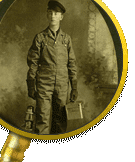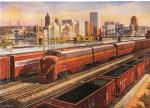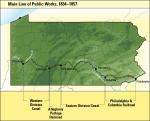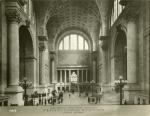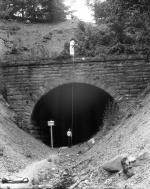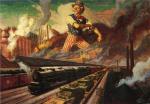Chapter Two: The Pennsylvania Railroad: "Standard of the World"
"Do not think of the Pennsylvania Railroad as a business enterprise. Think of it as a nation.... [It] is perhaps as nearly self-sufficient as the U.S. Army itself."
Fortune magazine, May, 1936
Conceived as a Philadelphia-based line originally designed to cross Pennsylvania, the Pennsylvania Railroad (PRR) grew to become the single most important railroad in America. Its original charter specified a route that connected Philadelphia with Pittsburgh, but the company's astute president,
By the time Thomson died in 1874, PRR's web of affiliated lines connected New York, Philadelphia, Baltimore, and Washington with Buffalo, Cleveland, Pittsburgh, Cincinnati, Indianapolis, Louisville, Chicago, and St. Louis in the west. By the 1880s, the PRR had become the dominant east-west trunk line in the nation. The PRR of this era defined almost everything it did in terms of the biggest and the best.
The idea for a transportation system reaching across Pennsylvania to Pittsburgh and the Midwest really began in the 1820s, when the opening of the Erie Canal shocked Philadelphia merchants into an awareness that their city would now be bypassed as a port city and trade center by New York. Opened in 1834, Pennsylvania's Main Line of Public Works created an interlocking system of
Incorporated in 1846, the PRR was intended to finally do the job that the Main Line system had failed to do. The PRR opened its first sixty-one mile stretch from Harrisburg to
By 1850, the PRR line reached
Soon afterward, the railroad took control of the state's
After the end of the Civil War, the PRR also bought up real estate and developed towns along its tracks, especially along the "Main Line" that extended some twenty miles west of Philadelphia. There the railroad erected lavish depots, like the gingerbread-decked Strafford station (an exhibit at the 1876 Centennial Exposition in Philadelphia), and built the
At its peak of operation in the 1920s, PRR boasted 28,000 miles of track and 279,000 employees. At the same time, it was running 6,700 trains a day, transporting fully 10 percent of all freight in America, and 20 percent of all passengers. Dubbed "the big red subway," after the Tuscan-red color of its passenger cars, the PRR at one time consisted of more than 600 separate corporations that included other railroads, steamship and bus lines, and a vast array of companies that represented everything from real estate to warehouses. One of the nation's largest and most powerful economic enterprises, the company faithfully paid its stockholders for 122 consecutive years (a record that still stands), until failing in 1970 after an ill-planned merger with its rival, the New York Central Railroad.
The headquarters of this transportation Goliath was in Philadelphia, always within a few blocks of City Hall. PRR's grandiose passenger stations included the landmark Pennsylvania Station in New York City,
A leader in many aspects of industrial growth, PRR pioneered important improvements in railroad safety and efficiency, including signal and control devices,
The company did not, however, always apply the same forward-thinking efforts to its workers. After imposing wage cuts and demands for more productivity, PRR became the target of worker outrage in the deadly and costly
When Congress passed the Railway Labor Act in 1926, which mandated collective bargaining for railroads and prohibited reprisals against employees who joined a union, PRR successfully fought the federal government and defended its right to administer company-sponsored unions. Dubbed "employee representation" unions, they were outlawed only with the passage in the 1930s of labor-friendly legislation under President Franklin D. Roosevelt.
PRR's sharp-penciled methods did not, however, protect it from competition. In the 1880s, the rival New York Central Railroad joined with
In the 1920s, PRR boasted that it carried more freight over the Alleghenies in a single day than the old state-owned
In the early 1900s, the PRR published one version of its safety rulebook in twelve languages. Like those of other railroads, PRR's workforce was ethnically divided. Advancement favored those who were white, Anglo-Saxon, and conservatively Protestant, preferably Presbyterian or Episcopal. Being a Freemason also improved one's chances of advancement, particularly for young apprentices aspiring to management from the training grounds of PRR's immense shop complex in Altoona.
Despite these clear ethnic, religious, and class distinctions, PRR mounted a large-scale effort to build camaraderie. It sponsored company sports teams, bands, and civic organizations. Each year, dozens of trains converged on an on-line town, bringing hundreds of athletes and spectators for a system-wide athletic tournament with track, baseball, boxing, and wrestling. After the federal prohibition of company unions, PRR continued to sponsor bowling, baseball and basketball teams and musical choruses. Even as late as the 1960s, "Pennsy Family Clubs" held picnics and dances, and sponsored civic events.
Proud of its great accomplishments, PRR labeled itself "The Standard Railroad of America" and later, "The Standard Railroad of the World." But while no one disputes its role as an industry leader, its engineering preferences, operating practices, and even nomenclature were rarely copied by other railroads. Some examples: On the PRR, a switching locomotive was a shifter; a caboose was a cabin car; an employee who was laid off was furloughed. On multiple-track main lines, the tracks were designated with numbers from south to north, while on all other railroads, they were numbered from north to south.
After World War II, the company found it hard to stay afloat in a world of government regulation, massive federal and state subsidies to its competitors, and growing competition from a booming American trucking industry. It declared its first loss in 1946, followed by two more in 1960 and 1962, and then merged with its rival, the New York Central. That unhappy 1968 marriage created the unfortunate Penn Central system, whose mismanagement escorted it into bankruptcy in only 870 days, the largest corporate failure on Wall Street at the time.


